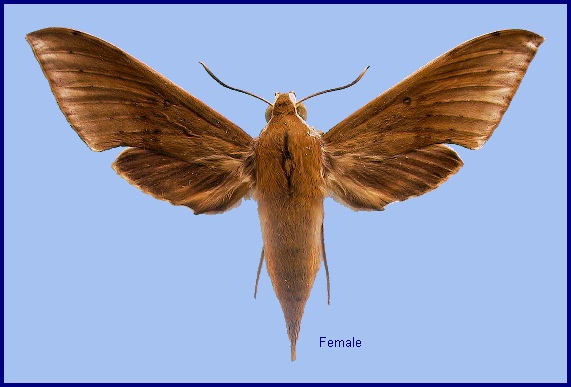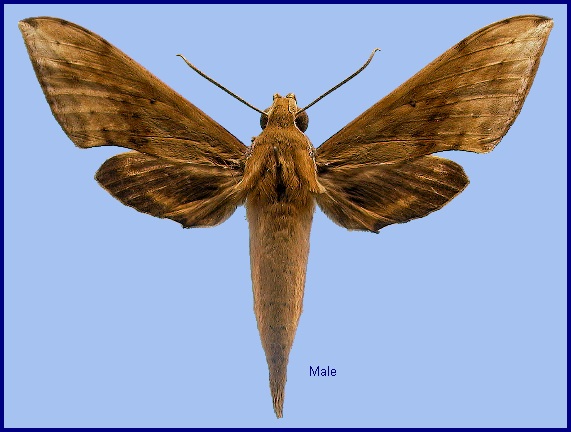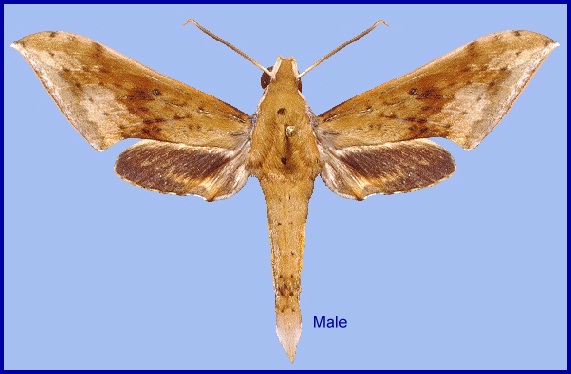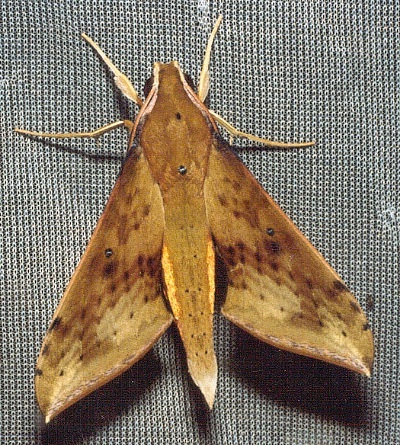


Pergesa aurifera Butler, 1875, Proc. zool. Soc. Lond. 1875: 7. Type locality: [India,] Sikkim.
Synonym. Pergesa aurifera Butler, 1875.
Wingspan: 70--84mm. Wings more elongate than in Rhagastis velata (Walker, 1866) and Rhagastis acuta (Walker, 1856). Underside of abdomen and mesometasternum creamy-white; forewing with marginal area joined to basal area by a streak behind M2 , the row of dots of the same wing heavy. In some individuals disc of forewing upperside buffish distally near apex of wing and posterior angle, and the brown marginal area of the underside becomes also clearly marked above. Metanotum with black mesial dot. Abdomen with, a distinct ochre-buff lateral stripe from segments 4 to 7, the stripe often extending basad to segment 3. Cavity of first segment of palpus distinct; second segment broadest at base, longer than broad. Black apical scaling of antenna extending over ten or more segments. External row of spines of first protarsal segment double.
Male near identical to Rhagastis castor (Walker, 1856), but the adult size is smaller and the colour tends to be greenish-brown. Forewing wider and straighter than that of R. castor; upper side ground colour greenish brown, a yellowish oval patch across the postmedian lines, middle area with black zigzag dotted lines and a black patch near the discal spot, a triangular black patch near the apex, submarginal area covered by a pink-grayish patch; underside colour and patterns deeper and more obvious than in R. castor. Hindwing dark gray-black with a slender yellowish stripe across the middle area to the tornus; underside colour and patterns deeper and more obvious than in R. castor, the grayish zigzag medial line dotted with some black spots. Female similar to the male but with broader wings and slightly paler ground colour; patterns of the forewing and hindwing paler than in the male (Jiang et al., 2024).
Male genitalia similar to that of R. castor, but the uncus is shorter. Valva more rounded. Sacculus thicker and apex obviously blunt. The phallus is shorter, with the anterior lobe of the process thicker than in R. castor and with gross apical serration (Jiang et al., 2024).

China: vi-vii (Yunnan) (Jiang et al., 2024).
OVUM: Green when fist laid, yellow before hatching (Bell & Scott, 1937).
LARVA: Full-fed 85mm, width 11mm, horn 5 mm. According to Bell & Scott (1937), in the first instar pale yellow with a short straight black horn; after feeding median segments green. In the second instar, head yellow, body green, with an eye-spot on segment 5 black edged with white; horn black with red base. By the third instar, head green, body bluish-green, with a white dorso-lateral stripe on 2 to 4. Eye-spot with pupil dark blue in front, green behind, edged broadly with white and narrowly with black. There are seven white oblique lateral stripes forming a waved line. In the fourth instar, head and segments 2 and 3 dark green, rest of body bluish-green. There is a dark green dorsal stripe, and a narrow dorso-lateral stripe on 2 to 4. The eye-spot has some white dots in the green portion of the pupil, the pupil edged narrowly with first white and then green. The oblique lateral stripes on 6 to 10 are pale blue crossed by short dark blue lines. Horn of medium length, somewhat square cross-section, straight to near tip, then bent downwards, hardly tapering, upper surface dark purple, lower surface brown.
In the fifth and final instar, shape similar to that of larvae of the genus Theretra, with segment 5 considerably swollen. Head smooth and moderately shiny, body smooth and dull. Horn held at an angle of about 45° to body, of medium length, somewhat flattened laterally, tapering gently to a slightly bulbous tip, tip bent slightly downwards; surface dull and smooth except for small round tubercles on the dorsal surface (Bell & Scott, 1937).
Head and segments 2 to 5 pale sap-green, rest of body pale yellow dorsally, becoming pale blue dorso-laterally and pale grass-green dotted with darker green laterally and ventrally. A very narrow, dark green dorsal stripe is present from 2 to base of horn, disappearing in the middle of each segment. There is also a narrow white dorsal stripe on 2 to 4. The large oval eye-spot on 5 has a front edge encroaching on to 4, long axis inclined backwards and slightly upwards, pupil dark blue in front, sap-green behind, the green containing one large and several small white spots, the pupil edged broadly below, narrowly elsewhere with pure white, this again edged narrowly with sap-green. A bright yellow patch occurs on the dorsum between the eye-spot, and running forward on to 4. There are broad, pale, chalky-bluish oblique lateral stripes on 6 to 10, that on 10 running through the spiracle on that segment and crossing 11 and 12 to base of horn, all edged above with sap-green. A dorso-lateral lunule formed of pale bluish spots ringed with dark green occurs on 6 to 10, the lunules curved convexedly dorsad and forming backward extensions to the upper edges of the oblique stripes. Horn reddish-purple, the tubercles black; legs pink. Spiracles white edged with dark green (Bell & Scott, 1937).
Anterior segments of larva more retractile than in R. velata. The larva, when alarmed adopts the snake-like attitude of Theretra larvae, retracting the head and anterior segments into the swollen segment 5, and waving the head and anterior segments from side to side (Bell & Scott, 1937).
PUPA: 50mm, width 10mm. Colour of head, thorax and wing-case dark brown speckled and streaked with black, especially on dorsum; abdomen pale brown dorsally and ventrally, sides black with large, irregular, white patches round the spiracles; wing-case separated from abdomen by a conspicuous white line from base to near tip; bevels of free abdominal segments pink (Bell & Scott, 1937).
Tongue-case projecting considerably in front of head, semi-circular in side-view; head with frons sloping steeply downwards, and between it and upper edge of base of tongue-case there is a sharp transverse dorsal ridge. From the lower edge of the tongue-case the ventral surface is concave to the middle of wing-case, then convex to the tip of wing-case, the curves being more strongly developed than in others of the genus. Surface dull, tongue-sheath coarsely rugose, veins of wings and legs prominent and set with tubercles; rest of body smooth. Spiracles white with a broad black band across the middle. Cremaster triangular, upper surface rugose underside deeply hollowed, ending in two cylindrical shafts, each of which branches into two spines; two or three double-pointed spines on lateral edge of cremaster near tip (Bell & Scott, 1937).
The pupa when handled moves the abdominal segments freely.

Larval hostplants. Amorphophallus (Araceae) and Vitis (Vitaceae) in India (Bell & Scott, 1937).
Unknown.
China: Yunnan (Malipo, 1370m; Mengla, 950m).
Nepal, Bhutan (Irungbam & Irungbam, 2019), northeastern India, Thailand, southern China (Yunnan), Laos, Vietnam (Le & Vu, 2024) and Peninsular Malaysia.
[The related Rhagastis castor (Walker, 1856) occurs on Sumatra, Java and Borneo (Indonesia/Malaysia), and Rhagastis formosana Clark, 1925 is endemic to Taiwan.]

Map: Distribution of species of the castor group of the genus Rhagastis. The blue dotted line indicates the range of R. chinensis, the red dotted line indicates the range of R. aurifera, the green dotted line indicates the range of R. castor, and the orange circle indicates the range of R. formosana (© Jiang, Wang, Xu, Kitching, Huang, Hu & Xiao, 2024).
 Return to Sphingidae of the Eastern Palaearctic species list
Return to Sphingidae of the Eastern Palaearctic species list